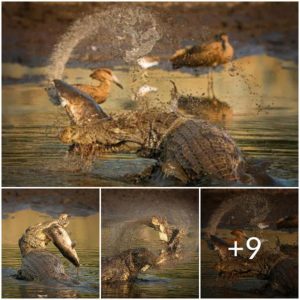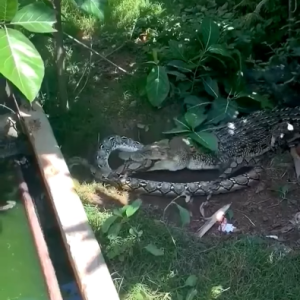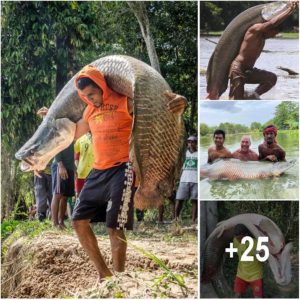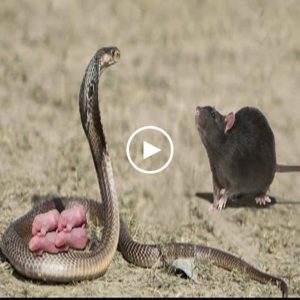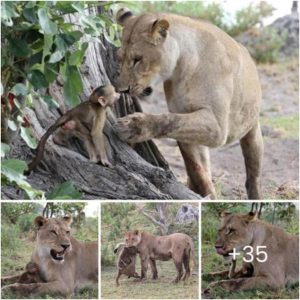Megalania prisca, the largest terrestrial lizard known, was a giant goanna (monitor lizard).

First described from the Darling Downs in Queensland by Sir Richard Owen in 1859, Megalania lived in a variety of eastern Australian Pleistocene habitats open forests, woodlands and perhaps grasslands.

Megalania would have been a formidable reptilian predator like its relative the Komodo Dragon of Indonesia, and may have eaten large mammals, snakes, other reptiles and birds.

Megalania prisca was an enormous monitor lizard up to 5 metres long with an unusual crest on its snout (a smaller but similar crest is also seen in the perentie, Varanus giganateus and in other Australian species).

The teeth of Megalania were sharp and recurved with wrinkled, infolded enamel. Megalania had small bones (osteoderms) embedded in the skin of the snout and nape of the neck.

Its postcranial skeleton is poorly known, but its proportions were unlike those of other monitors.

The humerus (upper arm bone) was unusually wide at its distal (far) end, unlike other varanids, where the distal end is about as wide as the proximal (near) end.

– Habitat –Megalania lived in a broad range of Pleistocene habitats, including open forests, woodlands and perhaps grasslands.

Fossils have been found in stream and river deposits as well as in caves. It was rare in all localities, and was probably not living on stream banks or in caves.

– Distribution –Megalania was widely distributed across much of eastern Australia although complete fossils are rare.

In Queensland, Megalania has been found at Bluff Downs and Wyandotte in the north, Marmor Quarry near Rockhampton on the south coast, and the Darling Downs in the southeastern of the state.

In New South Wales, Megalania has been found at Cuddie Springs in north central NSW and at Wellington Caves, central NSW. Victorian Megalania fossils come from the southern coastal region.

In South Australia, Megalania has been found in the arid Lake Eyre region (Warburton River, Cooper Creek and Lake Kanunka) and at Naracoorte Caves near the South Australian coast. Megalania is not yet known from Tasmania, Western Australia or New Guinea.

– Feeding and diet –Remains of Megalania have often been found with fossils of large animals like kangaroos, suggesting that Megalania may have taken large prey, like the ora or Komodo Dragon.

Living oras consume large mammals, including deer, wild pigs and goats. Prior to human arrival on the islands where it lives, it probably preyed on now-extinct pygmy elephants and possibly tortoises.

Like other varanids, Megalania may have been an ambush predator/scavenger whose toxic saliva would have caused infection and death to its victims.

In spite of its large size, Megalania would have needed much less to eat than a mammalian predator of comparable size.

– Life history cycle –Lizards have formed a large part of the vertebrate fauna of Australia since at least the Miocene.

Megalania, a huge varanid lizard, was part of a suite of large Australian Pleistocene reptiles that included giant horned turtles, crocodiles like Pallimnarchus and large snakes like Wonambi naracoortensis.

It would have been a top predator, most likely feeding on large vertebrates, during the Australian Pleistocene.

However, skeletal remains of Megalania are fragmentary, and much is unknown about its life history.

– Fossils description –No complete skeletons or intact skulls of Megalania are known, and the limited amount of skull material found to date was not associated with postcranial material.

Vertebrae and isolated teeth are the most common fossils, and lower jaws and limb bones have also been found.

A humerus (upper arm bone) of a very large varanid, probably that of a juvenile Megalania, was found at Naracoorte Caves in South Australia.

The skeleton of Megalania was reconstructed by Victorian palaeontologist Dr Tom Rich and is on display at the Museum of Victoria.

There may be a second species of Megalania, from the Pliocene of the Darling Downs, south east Queensland.

– Evolutionary relationships –Varanids are more closely related to snakes rather than to other lizards.

Molecular evidence suggests that varanids evolved during the Early Cretaceous (between 140-100 million years ago) although there is no fossil evidence yet for this. Varanids would have arrived in Australia from Asia across ‘micro-continents’ , which have been in existence between Australia and Asia since the Early Cretaceous.


